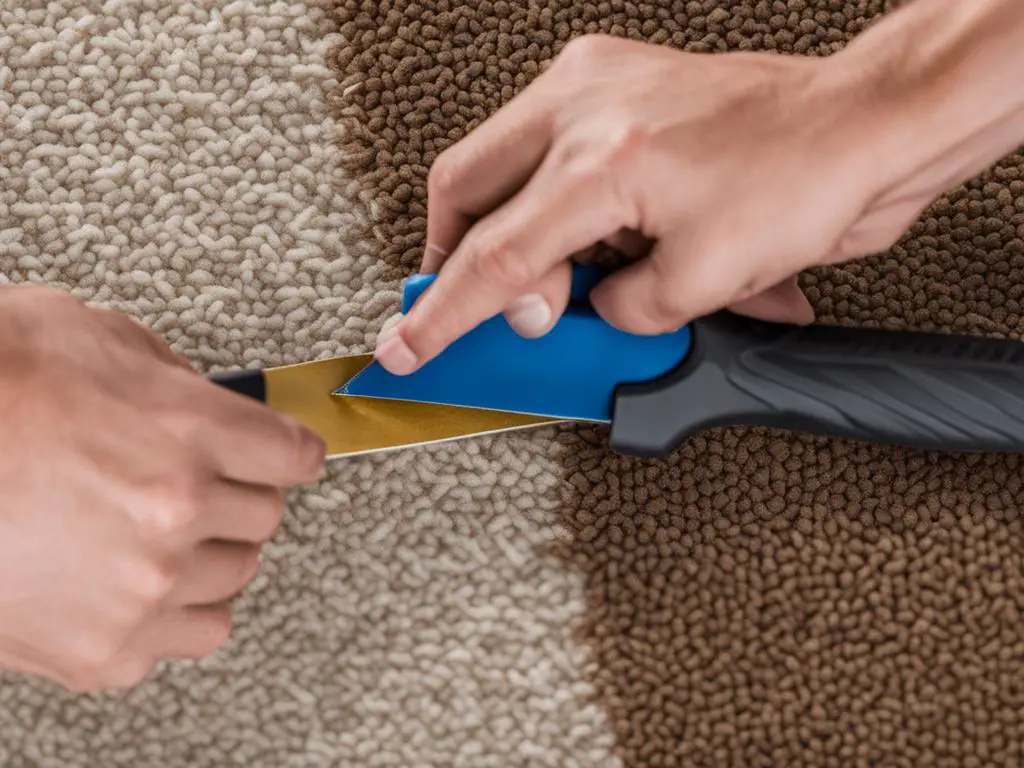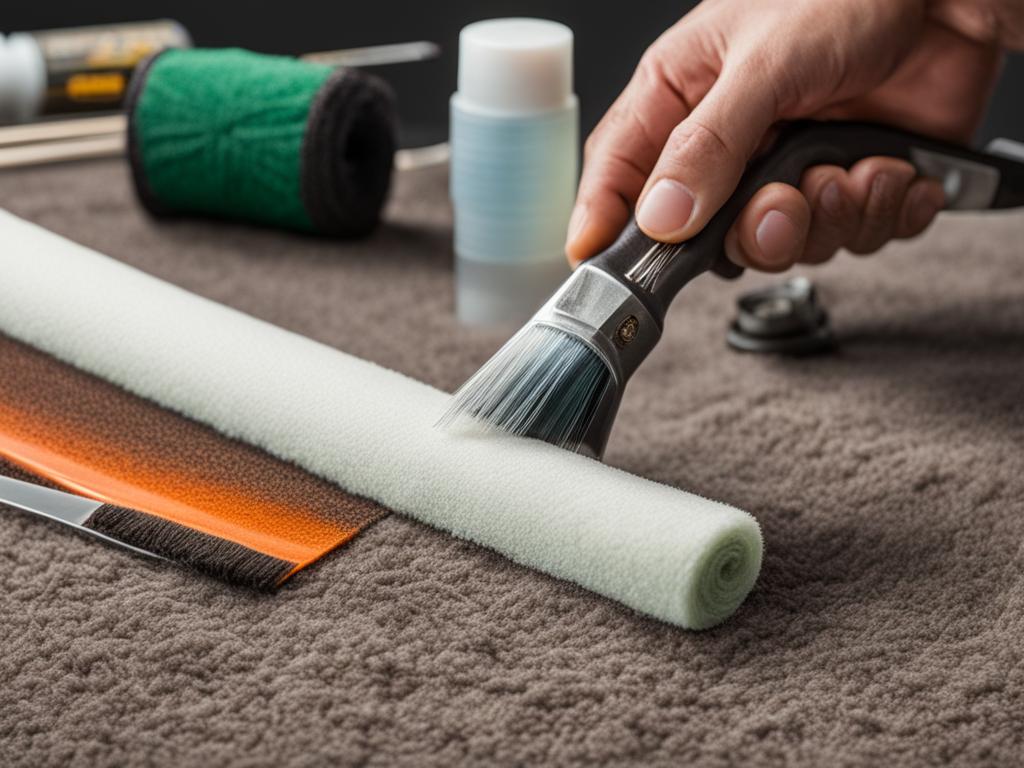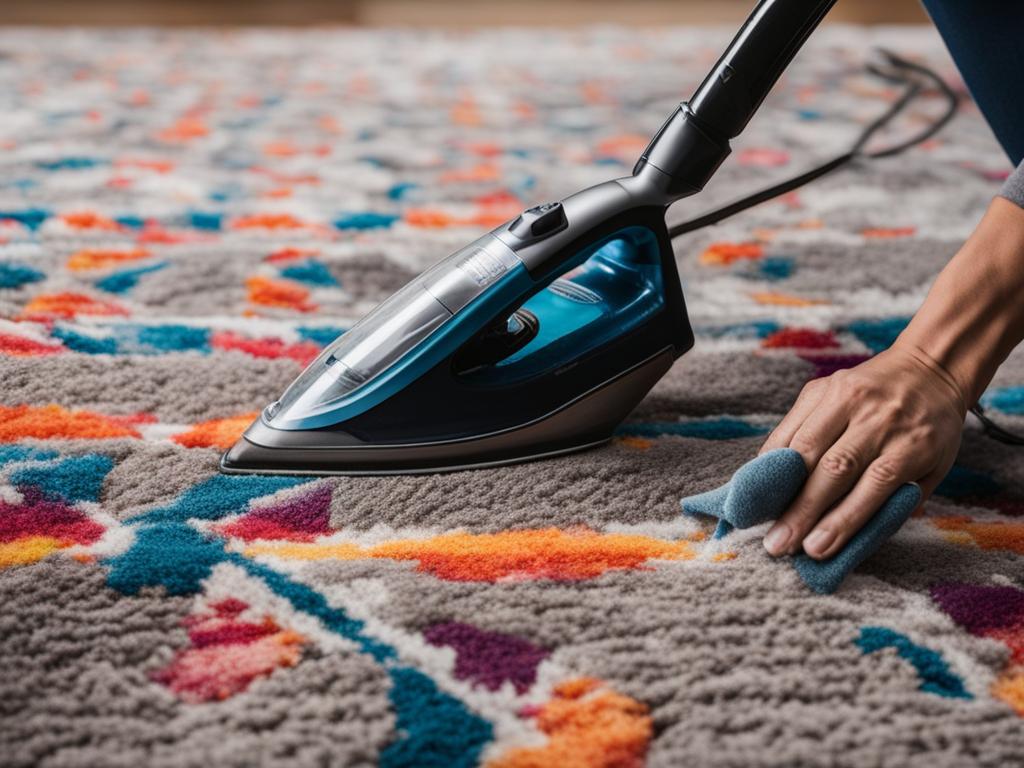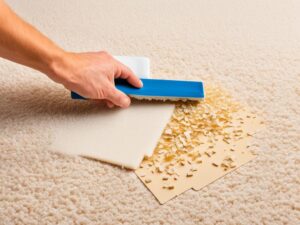If you have adhesive residue on your carpet, it’s important to remove it promptly to prevent it from attracting dirt and becoming more difficult to clean. This article provides easy clean-up tips to remove adhesive from carpet effectively.
Key Takeaways:
- Adhesive residue on carpet can be unsightly and attract dirt.
- Removing fresh adhesive involves soaking up excess glue and using cleaning solutions like vinegar or dish soap.
- Adhesive tape can be removed by using distilled white vinegar or products like WD-40 and Goo Gone.
- Super glue stains on carpet can be tackled with acetone nail polish remover or gel solvents.
- An iron can be used to remove adhesive by applying heat and transferring the sticky substance to a cloth.
Methods for Removing Fresh Adhesive
Fresh adhesive can be a pesky problem when it ends up on your carpet. Fortunately, there are several effective methods you can try to remove it. Here are some easy steps to help you get rid of fresh adhesive and restore the beauty of your carpet:
- Remove Excess Glue: Start by gently removing any excess adhesive from the carpet using a towel or a spatula. Be careful not to spread the adhesive further.
- Soak up Wet Adhesive: If the adhesive is still wet, dampen a towel with water and gently dab the area to soak up as much glue as possible.
- Softening Dried Adhesive: For dried adhesive, dampen a towel with warm water. Press the towel onto the spot and let it sit for a few minutes to soften the glue.
- Try Distilled White Vinegar: Pour distilled white vinegar onto a cloth and gently wipe the adhesive area. Leave the vinegar on the carpet for at least 15 minutes before wiping it off.
- Mixture of Dish Soap and Warm Water: Create a solution by mixing dish soap and warm water. Apply the mixture to the adhesive, gently scrubbing the spot with a soft brush or cloth. Rinse the area with clean water and pat it dry.
These methods should help you remove fresh adhesive from your carpet. However, it’s important to test any cleaning solution or method on a small, inconspicuous area of your carpet first to ensure it doesn’t cause any damage or discoloration.
| Method | Advantages | Disadvantages |
|---|---|---|
| Removing Excess Glue | Quick and easy | N/A |
| Soaking up Wet Adhesive | Prevents the glue from spreading | May not be effective for larger spills |
| Softening Dried Adhesive | Eases the removal process | Requires some waiting time |
| Distilled White Vinegar | Natural and effective | May have a strong smell |
| Mixture of Dish Soap and Warm Water | Gentle on the carpet | Requires thorough rinsing |
Note: Remember to always follow the manufacturer’s instructions and guidelines when using cleaning products on your carpet.
Expert Tip:
“For stubborn adhesive, you can also try using a commercial carpet adhesive remover. These products are specifically designed to break down and remove tough adhesive stains from carpets. Follow the instructions on the product label and test it on a small, hidden area of your carpet before applying it to the affected spot.”
With these methods and tips, you can effectively tackle fresh adhesive on your carpet and keep your floors looking clean and adhesive-free.
Removing Adhesive Tape from Carpet
Removing adhesive tape from carpet can be a challenging task. However, with the right methods, you can effectively tackle this issue.
Begin by removing as much of the tape as possible, gently peeling it off without causing damage to the carpet fibers. Be careful not to pull too hard, as this may result in tearing or leaving behind sticky residue.
Once the tape is removed, there are a few different approaches you can take to eliminate any adhesive stains or residue:
- Distilled White Vinegar Method: Pour distilled white vinegar onto a cloth and gently rub the affected area. Allow the vinegar to sit on the carpet for at least 15 minutes to loosen the adhesive. Then, use a clean cloth to blot and remove the residue.
- WD-40 Method: Applying a small amount of WD-40 to the adhesive residue can help break it down. After spraying the WD-40, use a plastic scraper or old credit card to gently scrape away the softened adhesive. Wipe the area with a damp cloth to remove any remaining residue.
- Rubbing Alcohol Method: Dabbing rubbing alcohol onto a cloth and gently rubbing it on the adhesive can help dissolve the sticky residue. Continuously dampen the cloth with rubbing alcohol as you work, and don’t forget to blot the area with a clean cloth afterward.
Remember to test any cleaning solution in an inconspicuous area first to ensure it doesn’t cause damage or discoloration to your carpet.
Removing Adhesive Tape from Carpet – Expert Tip:
If the adhesive tape has been on the carpet for an extended period, it may require more than one attempt to fully remove the residue. Patience and persistence are key to achieving the best results.

Carpet Glue Remover Comparison Table:
| Carpet Glue Remover | Pros | Cons |
|---|---|---|
| Distilled White Vinegar | – Gentler option for sensitive carpet fibers – Cheap and readily available |
– May require multiple applications – Strong vinegar smell |
| WD-40 | – Effective in breaking down adhesive residue – Easy to use |
– Strong odor – Requires thorough cleaning after use |
| Rubbing Alcohol | – Quick-drying solution – Can be used on a wide range of adhesive types |
– May cause discoloration or damage to certain carpet materials – Flammable, handle with care |
Removing Super Glue from Carpet
Super glue stains on carpets can be stubborn, but with the right techniques, you can effectively remove them. Follow these adhesive removal techniques to get rid of sticky substances from your carpet.
Method 1: Acetone Nail Polish Remover
Start by applying acetone nail polish remover to a cotton ball or cloth. Gently dab the affected area with the cotton ball, ensuring not to rub it vigorously. It’s essential to test the acetone on a small, inconspicuous area of your carpet first to ensure it doesn’t cause any damage. Once you’ve determined that it is safe, proceed to dab the super glue stain with acetone until it starts to dissolve. Wipe away any residue with a clean, damp cloth.
Method 2: d-Limonene or Gel Solvent
If you prefer a natural cleaning solution, you can try using a product that contains d-Limonene. Apply the d-Limonene-based cleaner to the super glue stain and let it sit for a few minutes. Then, use a clean cloth to gently scrub the area until the glue starts to loosen. Wipe away any remaining residue with a damp cloth. Alternatively, you can use a gel solvent like Goo Gone by following the instructions on the product label. Apply the gel solvent to the super glue stain, allow it to penetrate the glue, and then wipe it away with a damp cloth.
| Method | Materials | Steps |
|---|---|---|
| Acetone Nail Polish Remover | – Acetone nail polish remover – Cotton ball or cloth – Clean, damp cloth |
1. Test acetone on a small area. 2. Dab super glue stain with acetone. 3. Wipe away residue with a damp cloth. |
| d-Limonene or Gel Solvent | – Product containing d-Limonene or gel solvent – Clean cloth – Damp cloth |
1. Apply d-Limonene-based cleaner or gel solvent. 2. Let it sit for a few minutes. 3. Gently scrub the area. 4. Wipe away residue with a damp cloth. |
Remember to use caution when using any cleaning product on your carpet. Always follow the instructions provided by the manufacturer and test the product in a small, inconspicuous area before using it on larger, more visible areas. With these adhesive removal techniques, you can effectively remove super glue stains from your carpet.

Using an Iron to Remove Adhesive
If you’re dealing with stubborn adhesive stains on your carpet, using an iron can be an effective method to remove them. Follow these steps to safely and efficiently eliminate adhesive from your carpet:
- Start by placing a paper towel over the adhesive spot to protect the carpet fibers. This will prevent any direct contact between the iron and the glue.
- Next, cover the paper towel with a clean cloth. This additional layer helps to evenly distribute the heat.
- Set your iron to the highest steam setting. The steam will help loosen the adhesive from the carpet fibers.
- Gently press the iron over the cloth, directly above the adhesive spot. Move the iron in a circular motion for about 10 seconds. Avoid applying excessive pressure to prevent damaging the carpet.
- After ironing, carefully peel back the paper towel and cloth to check if the adhesive has transferred. If you notice the glue on the paper towel or cloth, it means the method is working.
- For larger or more stubborn adhesive stains, it’s essential to test a small area first before treating the entire spot. This ensures that the heat from the iron doesn’t cause any discoloration or damage to your carpet.
- Remember to use caution when handling a hot iron, and always follow the manufacturer’s instructions.
By using an iron to remove adhesive from your carpet, you can effectively eliminate unsightly stains without the need for harsh chemicals or expensive professional services.
Here’s an image to help you visualize the process:

Conclusion
Removing adhesive from carpet can be a challenging task, but fear not – there are effective techniques and products available to help you clean up the mess. Whether you’re dealing with fresh adhesive, adhesive tape, or even stubborn super glue stains, there are various methods you can try to remove the sticky substance from your carpet.
One effective method is to use a carpet adhesive remover, specifically designed to tackle adhesive residue. These products are formulated to break down and dissolve the sticky substance, making it easier to remove from the carpet fibers. Simply follow the instructions on the product label for best results.
Another popular technique is to use household items like vinegar and dish soap or even WD-40. Vinegar works well to loosen and dissolve sticky residues, while dish soap can help to break down the adhesive. WD-40, on the other hand, is particularly effective for removing adhesive tape and super glue stains. Remember to always test any cleaning solution in a hidden area first and proceed with caution.
For more stubborn adhesive stains, you can try using an iron. Place a paper towel or cloth over the spot, then set the iron to the highest steam setting. Gently iron over the cloth for a few seconds, allowing the heat and steam to loosen the adhesive. Always be careful when using heat on your carpet and test a small area before proceeding.
By utilizing these adhesive removal techniques and products, you can say goodbye to sticky residue and enjoy a clean and adhesive-free carpet once again. Remember to always treat stains promptly and follow the recommended cleaning methods to ensure the best possible results.
FAQ
How do I remove fresh adhesive from my carpet?
Start by removing any excess glue with a towel. If the adhesive is still wet, use a damp towel to soak it up. For dried adhesive, dampen a towel with warm water and press it onto the spot to soften the glue. You can also try using distilled white vinegar or a mixture of dish soap and warm water to clean the area.
What are the best methods for removing adhesive tape from carpet?
Start by removing as much of the tape as possible. Then, you can try using distilled white vinegar or WD-40 to dissolve the adhesive. Scrub the area gently and use a carpet cleaner like Goo Gone to remove any residue. Rubbing alcohol can also be effective in removing adhesive tape stains.
How can I remove super glue from my carpet?
You can try using acetone nail polish remover or a product that contains d-Limonene, a natural cleaning solution, to remove super glue stains. Test the solution on a small area first to ensure it doesn’t damage the carpet. Another option is to use a gel solvent like Goo Gone and wipe away any residue with a wet cloth.
Can I use an iron to remove adhesive from my carpet?
Yes, an iron can be used to remove adhesive from carpet. Place a paper towel over the spot and cover it with a clean cloth. Set the iron to the highest steam setting and iron over the cloth for about 10 seconds. Peel back the paper towel and cloth to check if the adhesive has transferred. Use caution and test a small area before proceeding.
What are some other adhesive removal techniques for carpet?
In addition to the methods mentioned above, you can try using vinegar and dish soap, or even a carpet cleaner specifically designed for removing adhesive residue. Just make sure to test any cleaning solution in a hidden area first and follow the instructions carefully.



